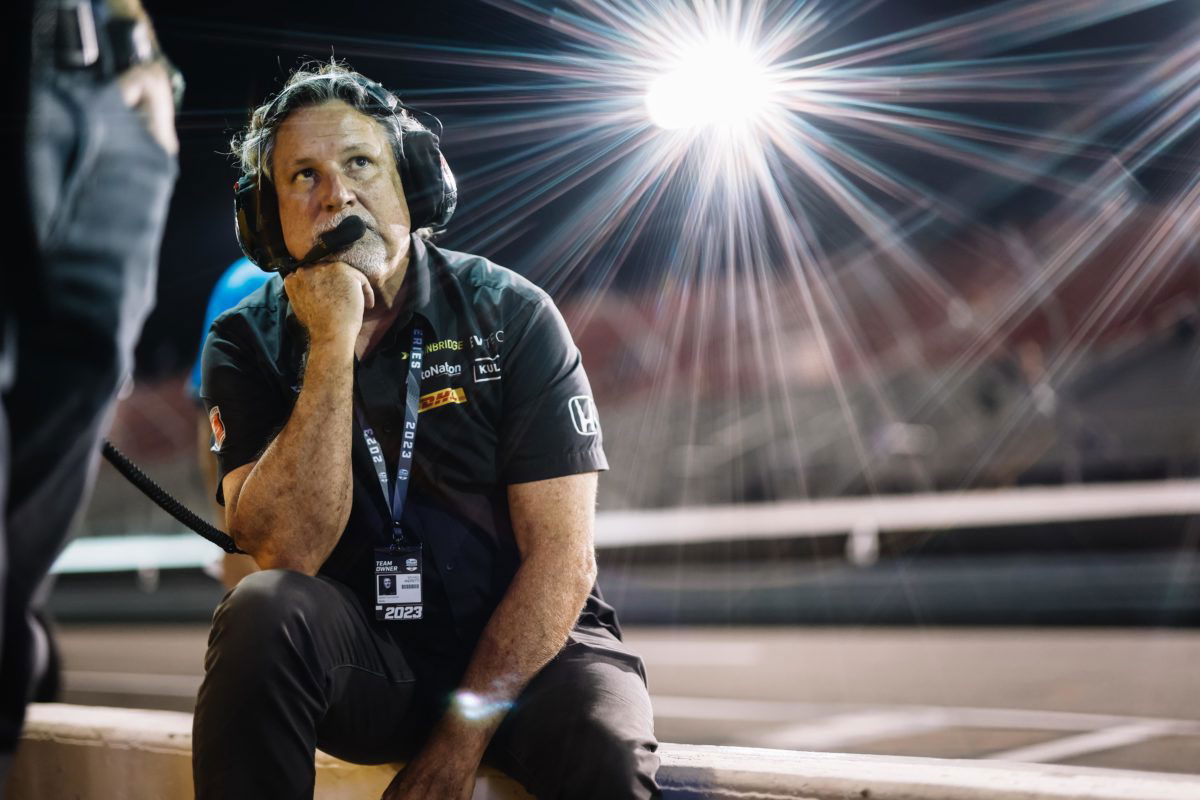

The impact of Andretti Global as an 11th team on the F1 grid is, in financial terms, significantly less than some would have us believe.
Andretti Global has had its application to join F1 approved by the FIA, a process it advises has seen the American team progress to the ‘next phase’.
It was the only one of four aspiring teams to make the grade, as announced by the governing body in the lead-up to the Qatar Grand Prix.
However, there are no guarantees Andretti will ever be allowed to compete, with a further assessment now being undertaken by the sport’s commercial rights holders, Liberty Media.
That is understood to be centred on what value a new team can bring to the sport, or whether its addition will unreasonably jeopardise the health of the incumbents – though there is an anti-competition argument to be made in that instance.
Under the current Concorde Agreement, the document which lays out the commercial landscape of F1, up to 12 teams are permitted to compete.
Currently, only 10 do, meaning the prize fund set aside for teams is divided amongst just them.
Effectively, those currently competing in F1 are benefitting from a larger slice of the pie than, contractually, they are entitled to.
That they have grown accustomed to the increased stake is a fault on their part – good business would have them work to the worst-case scenario to be more robust organisations.
All figures quoted in this article are in US Dollars.
How F1 prize money is divided
Currently, teams enjoy a $35 million flat payment from F1 for taking part in the championship, a simple $350 million pot split 10 ways.
In addition to that is a performance-linked payment based on their constructors’ finishing position the previous year and some other bonuses for teams who’ve won multiple championships or finished in the top three of the previous year’s championship.
Ferrari also receives a bonus, believed to be five percent of the total prize money fund, which itself is calculated at 45 percent of F1’s forecast income for the current year.
Given Liberty Media is a listed company, its earnings are publicly available. For 2022, it had an income of $2.573 billion.
From that, we know the prize money fund was worth $1.158 billion.
It’s also known that performance-based payments are based on a sliding scale, understood to vary from 14 percent for the championship winner to six percent for the team that finishes 10th.
There is a separate $400 million fund that is split off. How it is distributed is unclear.
Nonetheless, we can calculate with some accuracy what each team earns through prize money.
For instance, with the information available we can estimate Red Bull received $84.4 million in prize money in 2022 as a result of finishing second in the championship in 2021.
Ferrari, which was third, earned $139.2 million after its bonuses were included, while Haas received just $56 million.
Estimated 2022 F1 prize money payments
| 2021 C’Ship | Team | Bonuses | Column 1 | Column 2 | Total |
| 1 | Mercedes | $ 3.6 | $ 35.0 | $ 49.0 | $ 87.6 |
| 2 | Red Bull | $ 3.6 | $ 35.0 | $ 45.8 | $ 84.4 |
| 3 | Ferrari | $ 61.5 | $ 35.0 | $ 42.7 | $ 139.2 |
| 4 | McLaren | $ 3.6 | $ 35.0 | $ 39.5 | $ 78.1 |
| 5 | Alpine | $ 3.6 | $ 35.0 | $ 36.4 | $ 75.0 |
| 6 | Scuderia AlphaTauri | $ 35.0 | $ 33.6 | $ 68.6 | |
| 7 | Aston Martin | $ 35.0 | $ 30.4 | $ 65.4 | |
| 8 | Williams | $ 3.6 | $ 35.0 | $ 27.3 | $ 65.9 |
| 9 | Alfa Romeo Sauber | $ 35.0 | $ 24.1 | $ 59.1 | |
| 10 | Haas | $ 35.0 | $ 21.0 | $ 56.0 |
Forecast 2023 F1 prize money payments
| 2022 C’Ship | Team | Bonuses | Column 1 | Column 2 | Total |
| 1 | Red Bull | $ 3.6 | $ 35.0 | $ 49.0 | $ 87.6 |
| 2 | Ferrari | $ 61.5 | $ 35.0 | $ 45.8 | $ 142.3 |
| 3 | Mercedes | $ 3.6 | $ 35.0 | $ 42.7 | $ 81.3 |
| 4 | Alpine | $ 3.6 | $ 35.0 | $ 39.5 | $ 78.1 |
| 5 | McLaren | $ 3.6 | $ 35.0 | $ 36.4 | $ 75.0 |
| 6 | Alfa Romeo Sauber | $ 35.0 | $ 33.6 | $ 68.6 | |
| 7 | Aston Martin | $ 35.0 | $ 30.4 | $ 65.4 | |
| 8 | Haas | $ 35.0 | $ 27.3 | $ 62.3 | |
| 9 | Scuderia AlphaTauri | $ 35.0 | $ 24.1 | $ 59.1 | |
| 10 | Williams | $ 3.6 | $ 35.0 | $ 21.0 | $ 59.6 |
It is important to note that while the prize money pot is paid out of the forecast earnings for that season, it is based upon the results of the previous year, meaning last year’s payments, derived from F1’s 2022 income, were made against the results of 2021.
In the first half of this year, F1 is much on par with its 2022 earnings, within one percent, meaning we can roughly forecast the year-end being much the same, too.
Red Bull, which won the 2022 constructors’ championship, will therefore likely pull in $87.6 million.
Ferrari, because it finished second last year, will see its income rise marginally to $142.3 million.
Meanwhile, Williams, which finished 10th in last year’s constructors’ championship, will only receive $59.6 million.
Armed with that information, how does the addition of an 11th team impact prize money payments?
Financial adjustments for Andretti Global in F1
What we can say with some certainty is that F1’s prize money fund will not get any larger, so the money will have to go further.
Ferrari will continue to receive its five percent bonus (though some sources suggest this is a flat $35 million sum rather than a percentage of income), while the ‘success’ bonus pot will also remain unchanged – worth around $3.6 million for each of the six currently eligible teams (Red Bull, Ferrari, Mercedes, Alpine, McLaren, and Williams).
From there, ‘Column 1’ payments, the flat fee paid out simply for competing, are assumed to reduce with the $350 million sum being split 11 ways rather than 10.
Each team would therefore receive $31.82 million instead of $35 million, a reduction of $3.18 million for the existing 10 teams.
However, given the prize money fund won’t increase, the performance-based payments would have to be adjusted.
To be consistent with Liberty Media’s stated ambition of levelling the playing field, it would be reasonable to suggest the six percent figure for the worst-performing team would not change, meaning a reduction in payments to those who performed well.
Currently, the world championship winner receives 14 percent of the pot, but if 11 teams competed it would be also fair to suggest that would proportionally reduce.
An equitable split would see that entitlement fall to around 12.18 percent, or $42.63 million.
A 0.62 percent (approximately) difference from one team to the next would see a largely linear sliding scale.
Under that system, second would receive 11.56 percent, third 10.95 percent, and so on down to 11th, which would receive six percent.
What if Andretti competed this year?
Hypothetically, if Andretti Global entered F1 this season, it would receive the lowest entitlement as it did not record a result in last year’s constructors’ championship.
Williams would therefore be entitled to the 10th place pot, Scuderia AlphaTauri ninth, and so on.
Knowing everything else, we can then hypothesise that Andretti would receive $52.8 million – $31.8 million for turning up and a further $21 million in performance-related prize money.
Williams would bring in $58.6 million, a reduction on its real-world forecasted return of $1.02 million.
Scuderia AlphaTauri would be worse off by $2 million and Haas by $2.99 million.
It is a system that weights the lost income based on a team’s success to limit the impact on the smaller teams – typically those who can least afford it.
It meant Red Bull would be $9.54 million worse off, a drop of around 12 percent of its prize money income.
However, Williams would be just two percent worse off, Scuderia AlphaTauri four percent, and Haas five percent.
Hypothetical 2023 prize money if Andretti Global were on the grid
| 2022 C’Ship | Team | Bonuses | Column 1 | Column 2 | Total |
| 1 | Red Bull | $ 3.6 | $ 31.8 | $ 42.6 | $ 78.0 |
| 2 | Ferrari | $ 61.5 | $ 31.8 | $ 40.5 | $ 133.8 |
| 3 | Mercedes | $ 3.6 | $ 31.8 | $ 38.3 | $ 73.7 |
| 4 | Alpine | $ 3.6 | $ 31.8 | $ 36.1 | $ 71.6 |
| 5 | McLaren | $ 3.6 | $ 31.8 | $ 34.0 | $ 69.4 |
| 6 | Alfa Romeo Sauber | $ 31.8 | $ 31.8 | $ 63.6 | |
| 7 | Aston Martin | $ 31.8 | $ 29.7 | $ 61.5 | |
| 8 | Haas | $ 31.8 | $ 27.5 | $ 59.3 | |
| 9 | Scuderia AlphaTauri | $ 31.8 | $ 25.3 | $ 57.1 | |
| 10 | Williams | $ 3.6 | $ 31.8 | $ 23.2 | $ 58.6 |
| Andretti | $ 31.8 | $ 21.0 | $ 52.8 |
Offsetting that is the antidilution fee, a $200 million sum payable to the sport and split equally among all existing teams.
The addition of Andretti would, therefore, see Williams better off to the tune of $19 million this year. Even Alfa Romeo Sauber, which finished sixth in 2022, would be more than $15 million better off.
There are other ways to carve up the prize money pie, of course, and some that more evenly distribute the lost income, but all of which leave teams arguably no worse off – or even ahead – of where they are now.
Of course, there comes a point in time when that equation changes, but it is several years away and affords Formula 1 time to grow its business to the point where there is no impact on the team’s finances.
The addition of Andretti Global to F1, therefore, does not look like the significant financial risk it has been made out to be.
There is an impact and it will require adjustments, though provision already exists for 12 teams under the Concorde Agreement and continued growth in the sport will easily counter that.
The crux of the matter is the addition of Andretti Global is far from the doom and gloom predicted by some in the F1 paddock.





















Discussion about this post